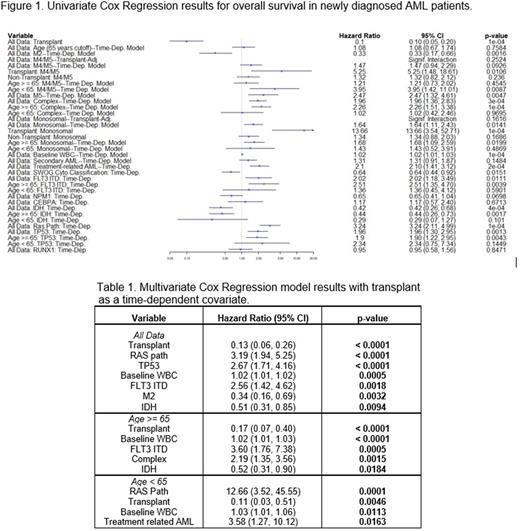Abstract
Introduction: For AML patients, both age at diagnosis and allogeneic stem cell transplant (SCT) are associated with overall survival (OS) (Shallis et al. 2019). For newly-diagnosed patients who are unfit for intensive therapy, Venetoclax (ven) + azacitidine (aza) (Ven/aza) is the standard of care. Median OS is 8.2 months and 17.5 months for older (>= 65 years) and younger (< 65 years) patients, respectively (Zeidan et al. 2020) (Dinardo 2018). In assessing OS, SCT is a confounder; selection for and receipt of SCT changes a patient's death risk. Thus, in clinical trials with OS as a primary outcome, appropriate data analysis should account for SCT. This study explores various OS analysis models in an effort to properly account for the confounding effect of SCT in the treatment of newly diagnosed AML patients with ven/aza.
Methods: To investigate OS in newly diagnosed Ven/aza patients, we reviewed charts at a single institution between January 2015 and December 2021. Demographic and clinical data were recorded for 181 individuals with complete follow-up. OS was defined as time from Ven/aza treatment to time of death or last follow-up. Multiple variations of Cox regression models were run to assess the effect of several variables of interest on OS. Analysis models included: 1) crude models ignoring SCT status, 2) SCT-adjusted models, and 3) models incorporating SCT as a time-dependent covariate. Lastly, interaction effects with age and/or SCT were considered in the Cox regression models to investigate the interplay of age, SCT, and ven/aza treatment in newly diagnosed AML patients. Kaplan-Meier methods were used to calculate median OS in the patient population and subpopulations.
Results: Median OS (95% CI) for the full data, SCT and non-SCT subpopulations, and older and younger subpopulations, are as follows: 8.5 months (6.8, 11.2), Not Reached and 5.8 months (4.3, 6.8), 8.1 months (6.3, 9.9) and 19.4 months (5.0, NR). Figure 1 presents Cox regression univariate results for OS in the data. Among the full dataset and accounting for SCT as a time-dependent covariate, SCT, M2 classification, Intermediate SWOG Cyto classification, and presence of an IDH mutation significantly improved OS in univariate models while M5 classification, complex karyotype, monosomal status, treatment-related AML, FLT3 ITD mutations, RAS pathway mutations, and TP53 mutations conferred significantly increased risk of death. By testing for significant interactions between age and other variables, the driver behind the significant results in the full data are more clearly explicated. Table 1 displays variables that retain significance (p<0.05) in multivariate Cox regression models with SCT as a time-dependent covariate. As shown, some variables do affect OS in the newly diagnosed AML population at large (SCT, M2, baseline WBC, and RAS pathway mutations). Other variables have significant effects on OS only in subpopulations: complex karyotype, FLT3 ITD mutations, and IDH mutations in the age >= 65 subpopulation (in addition to variables significant in the full dataset). Furthermore, M4/M5 classification and monosomal status are significant variables in the SCT subpopulation only.
Conclusions: Overall, Cox regression models are robust to correct handling of SCT, which should be treated as a time-dependent covariate. However, the nuanced effects of specific variables in age-dependent or transplant-dependent subpopulations vs. the entire population of newly diagnosed AML patients is missed when failing to model SCT in the Cox regression analysis appropriately.
Disclosures
McMahon:Syros: Research Funding; Arcellx: Consultancy.
Author notes
Asterisk with author names denotes non-ASH members.


This feature is available to Subscribers Only
Sign In or Create an Account Close Modal